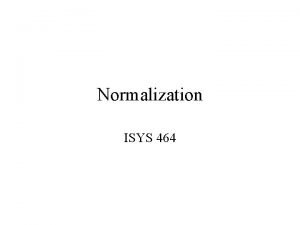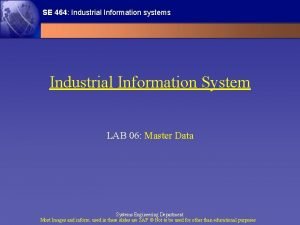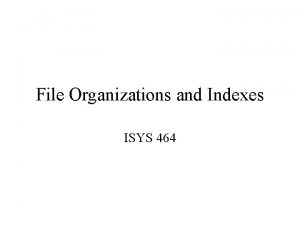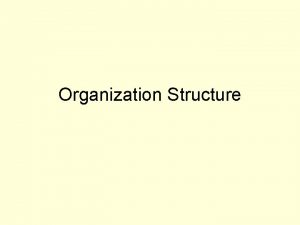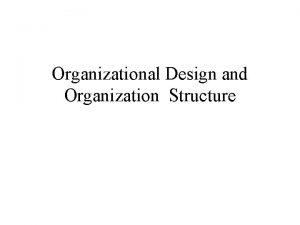Fin 464 Chapter 3 The Organization and Structure



















- Slides: 19

Fin 464 Chapter 3: The Organization and Structure of Banking Industry

3 -2 Introduction • We have explored many of the roles and services of the modern bank and competitors of banks • Over the years, bankers and the managers of competing financial institutions have evolved into different organizational forms • Organizational structure helps to follow the roles assigned to the firm • A financial institution’s role and size are not the only determinants of how it is organized or how well it performs. • Law and regulation shape the performance and diversity of financial-services organization.

3 -3 Advancing Size and Concentration of Assets ▫ Commercial banking is the dominant supplier of credit and payments services to businesses and households ▫ Many banks in the United States are small by global standards which is measured by the total assets held within the industry. ▫ In contrast, the American banking industry also contains some of the largest financial service organizations on the planet − Citigroup, JP Morgan Chase, and the Bank of America hold about 6 trillion dollars combined ▫ Largest financial institutions benefit from failing.

3 -4 Internal Organization of the Banking Firm • The great differences in size across the industry have organized differently the internal structure of the banks and other service providers. • The size factor has also influenced the variety of services provided by the financial institutions.

3 -5 Internal Organization of the Community Banks ▫ Devoted principally to the markets for smaller (individual or business), locally based deposits and loans and are often referred to as a retail bank. ▫ A bank with heavy involvement in consumer loans & deposits, and small business loans is called “Retail Bank”. ▫ Financial firms of this type stand in sharp contrast to wholesale banks. The bank which concentrates mainly upon serving commercial customers & making large corporate loans is called “Wholesale Institution”. ▫ Close contact between top management and staff of each division is common: ▫ Community banks are usually significantly impacted by changes in the health of the local economy and keeping up with new regulations

3 -6 Internal Organization of the Large Banks Larger Banks are Money Center Banks ▫ A large money center bank is usually located in a large city and has a focus towards wholesale or wholesale plus retail ▫ This bank is owned & controlled by a holding company whose stockholders elect a Board of Directors to oversee the bank & nonbank firms allied with the same holding company. ▫ Bank Holding Company is any company that has control over a bank. ▫ The largest institutions serve many different markets with many different services, they are better diversified – both geographically & product line – to withstand the risks of a fluctuating economy. ▫ Span of control is the key problem as top management less informed about the subsidiary companies ▫ Problems may not surface for months as offered in domestic & foreign markets

Internal Organization of the Large Banks ▫ Some of the largest banks have moved toward the profit-centered or performance approach − Each major department strives to maximize its contribution to profitability or to some other performance indicator ▫ The largest money-center banks possess some important advantages: i. Better diversified – both geographically and by product line ii. Can better withstand the risks of a fluctuating economy iii. Able to raise huge amounts of financial capital at relatively low cost iv. Can attract top managerial talent ▫ When a financial firm begins to grow, it usually adds new services and new facilities ▫ Financial firms now requires numbers of people with computer skills

3 -8 Types in Banking Industry: Unit Banking Organizations ▫ ▫ Unit banks, one of the oldest kinds, offer all of their services from one office Some services (such as taking deposits, cashing checks, or paying bills) may be offered from limited-service facilities such as ▫ Drive-up windows ▫ Automated teller machines (ATMs) ▫ Retail store point-of-sale terminals ▫ A drive-through, or drive-thru, is a type of service provided by a business that allows customers to purchase products without leaving their cars. ▫ Reasons for the large numbers of unit banks are: ▫ i. rapid formation of new banks ii. On-line banking Many customers still seem to prefer smaller banks, which often seem to know their customers better than larger banks Many new banks start out as unit organizations ▫

3 -9 Types in Banking Industry: Branching Organizations ▫ As a unit financial firm grows larger in size it usually decides at some point to establish a branching organization ▫ They offer the full range of services from several locations, including a head office and one or more full-service branch offices ▫ Likely to offer limited services through a supporting network of drive-in windows, ATMs, computers networked with the bank’s computers, point-of-sale terminals in stores and shopping centers, the Internet, and other advanced communications systems ▫ Senior management of a branching organization is usually located at the home office, though each full-service branch has its own management team with limited authority to make decisions on customer loan applications & other facets of daily operations. ▫ Services and functions in a branching organization are highly centralized.

3 -10 Branch Banking… (contd. . ) Reasons for the growth of Branch Banking: q Shifting of population from cities to suburban communities. q Bank failures causes healthier banks to take over sick ones & convert them into branch offices. q Growth of business increases the credit needs of rapidly growing corporations. q The passage of the Riegle-Neal Interstate Banking and Branching Efficiency Act in 1994 provided the basis for expansion − Recent years new bank branch office expansion appears to have slowed somewhat Advantages of Branch Banking: q q q Greater operating efficiency. Increases the availability & convenience of services to customers. Less transaction cost for the average customer Stimulate faster economic growth. Fewer bank failures because a branch bank is less dependent on the volume of business from single industry or local market area.

3 -11 Branch Banking… (contd. . ) § Argument Against Branch Banking: Drives out small competitors. Leaving the customer with fewer sources of banking services. Leads to higher service fees. Drains scarce capital away from local communities toward the largest cities. Slowing local economic development. Loans & deposits interest rates increases through mergers.

3 -12 Types in Banking Industry : Holding Company □ A bank holding company is simply a corporation chartered for the purpose of holding the stock of at least one bank, often along with other businesses □ Under Bank Holding Company Act, any company has control over a bank or over any company if— The company directly or indirectly or acting through one or more other persons owns, controls, or has power to vote 25 percent or more of any class of voting securities of the bank or company b. The company controls in any manner the election of at least two directors of at least one bank or company; or c. Prior approval taken from Fed. a. □ The principal advantage for holding companies entering nonbank lines of business is the prospect of diversifying sources of revenue and profits and reducing risk exposure □ The principal reasons for this rapid upsurge: ▫ Access to capital markets in raising funds ▫ Ability to use higher leverage (more debt to equity capitals) ▫ Tax advantages as can offset profits from one business with losses generated by other affiliated companies. ▫ Ability to expand into businesses outside banking

3 -13 Bank Holding Companies (contd…) Two types of Bank Holding Company 1. One Bank Holding Company: • It frequently own and control either one commercial bank or one or more nonbank businesses as well. • Nonbank business must offer services closely related to banking. For example nonbank business are finance companies, mortgage companies, investment banking firms, insurance companies , saving associations, etc. (check table 3 -4) 2. Multi-bank Holding Company • • A company that owns or controls two or more banks Requires approval from FED when wishes to acquire 5% or more of the equity shares of an additional bank. Banks acquired by holding companies are referred to as affiliated banks Banks not owned by holding companies are known as independent banks

3 -14 Bank Holding Company (contd. . ) Branch Banking pros and cons have been associated with holding companies Advantages: - Greater Efficiency - Different types of Services - Lower possibilities of Failure - Higher & stable profit Disadvantages: - Reduce competition - Increase service charges - Ignore the credit needs of small towns & cities - Accept higher fees

3 -15 Other forms of Bank Financial Holding Companies (FHC) □ □ Under the terms of the Gramm-Leach-Bliley (GLB) Act, financial holding companies (FHCs) are defined as a special type of holding company that may offer the broadest range of financial services, including dealing in and underwriting securities and selling and underwriting insurance Offers broadest range of financial services Each affiliated financial firm has its own capital, management, profit/loss which are separated form each other. So, each firm has protection against company-wide losses. Allowed the concept of universal banking Bank Subsidiaries (BS) − − Parent bank controls the subsidiaries and can offer different financial services. Profit/loss of each subsidiary affects the parent bank and thus the risk exposure is high. Size limits are imposed upon this (BS) form of organization

3 -16 Financial Firm Goals: Their Impact on Operating Cost, Efficiency, and Performance • Expense-Preference Behavior ▫ When the management of a financial firm decides that benefits for managers (and not the stockholders or the public) should be the primary objective of the company ▫ Opposite of cost control and efficiency • Agency Theory ▫ Analyzes relationships between a firm’s owners (stockholders) and its managers, who legally are agents for the owners ▫ Explores whether mechanisms exist in a given situation to compel managers to maximize the welfare of their firm’s owners • Lower agency costs and better company performance depend upon the effectiveness of corporate governance

Reasons for the Rapid Growth of Foreign Bank Activities 1. The financing of exports from the home country to host country. 2. Providing services to foreign nationals who have come to study or work. 3. Tapping the Money Market for liquid funds. 4. Assisting with the flow of foreign capital into the most promising local investments. 5. Avoiding regulatory restrictions on banking in their home countries by entering the more open local market. 17

Foreign Banks in Bangladesh 1. American Express Bank Ltd. 2. Citibank N. A 3. Commercial Bank of Ceylon Limited. 4. Habib Bank Ltd. 5. National Bank of Pakistan 6. Shamil Bank of Bahrain E. C. 7. Standard Chartered Bank Ltd. 8. State Bank of India 9. The Hong Kong and Shanghai Banking Cor. Ltd. (HSBC) 18

Foreign Bank penetration of Domestic Market Representative Offices: Facilities operated in a different region or nation from a bank’s home office that provide links back to the home office. Agency Offices: Offices that provide limited services to customers in distant markets, such as credit & cash management services. Full-Service Branches: Offices that provide the same full menu of services as a bank’s home office. Shell Branches: Special offshore facilities set up to raise new funds & avoid some regulations. 19
 Spf fin fod fin
Spf fin fod fin Prisme à base trapézoidale
Prisme à base trapézoidale Wees stil voor het aangezicht
Wees stil voor het aangezicht Hoeveel is 1 lb
Hoeveel is 1 lb Mil std 464
Mil std 464 Er diagram of online shopping
Er diagram of online shopping Kin 464
Kin 464 Se 464
Se 464 Isys 464
Isys 464 Kma 464 tahun 2020
Kma 464 tahun 2020 Mcitp sql 2012
Mcitp sql 2012 Isys 464
Isys 464 Isys 464
Isys 464 Kin 464
Kin 464 Cse logistics
Cse logistics Chapter 3 organization structure and culture
Chapter 3 organization structure and culture Block organization and point by point organization
Block organization and point by point organization Process organization in computer organization
Process organization in computer organization Hát kết hợp bộ gõ cơ thể
Hát kết hợp bộ gõ cơ thể Frameset trong html5
Frameset trong html5





